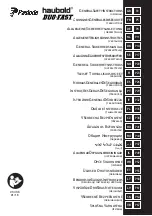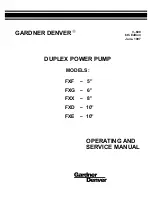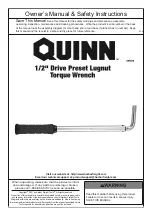
GENERAL SAFETY INSTRUCTIONS FOR THE USE OF
PNEUMATIC FASTENER DRIVING TOOLS.
- Original instructions -
Warning: Please read the instructions and warnings for this tool carefully before use. Failure to do
so could lead to serious injury
The Directive 2006/42/EC +
(1 ,62
lay down certain safety requirements for
hand-held non-electric power fastener driving tools,
and in your own interest we recommend you follow
these safety requirements without exception.
PNEUMATIC SYSTEM
Read and understand tool labels and manual.
Failure to follow warnings could result in
serious injury.
Operators and others in work area shall wear
impact-resistant eye protection with side
shields.
Operators and others in work area shall wear
hearing protection.
To warn that the tool has the capability of
operating in contact mode actuation mode.
This tool has either selective actuation for
contact actuation or continuous contact
actuation by actuation mode selectors or is a
contact actuation or continuous actuation
contact tool and has been marked with the
symbol above. Its intended uses are for production
applications such as pallets, furnitures, manufactured
housing, upholstery and sheating.
If using this tool in selective actuation mode, always
ensure it is in the correct actuation setting.
Do not use this tool in contact actuation for applications
such as closing boxes or crates and fitting transportation
safety systems on trailers lorries.
Be careful when changing from one driving location to
another.
The Pneumatic system consists of: tool and fasteners. In
the interests of operator and system safety, the tool,
and fasteners referred to in the Paslode/haubold/Duo-
Fast documents, must be considered as one single,
complete system.
Statement of use:
Paslode/haubold/DUO-FAST fasteners driving tools must
be used like described in the operating manual.
Fastener driving tools with continual contact actuation
or contact actuation shall only be used for production
applications.
General Safety Rules:
To drive fasteners into hard surfaces like steel &
concrete use the appropriated tools. Please refer to the
EC declaration of the tools. For these tools the angle
between the tool and the surface must not be superior
to 15°.
Multiple hazards. Read and understand the safety
instructions before connecting, disconnecting, loading,
operating, maintaining, changing accessories on, or
working near the tool. Failure to do so can result in
serious bodily injury.
When not in use, remove the fasteners and return the
tool to its carring case. Do not load fasteners with the
trigger and/or work-contacting element pressed.
Always assume the tool is loaded.
Check prior to each operation that the safety mechanism
is functioning properly.
Never put your hand on the front of the tool. The tool
must be operated only when it is in contact with the
material to be fixed.
Ensure that you use the correct length of fastener with
the depth adjuster correctly set, so that nails do not
protrude when a fixing is made.
Do not drive fasteners into knots or on top of other
fasteners.
Never drive fasteners into areas with concealed hazards.
The temperature of the tool may increase depending on
the firing frequency. Observe the maximum cycle rates
given in the operating instructions.
We recommend that you carry out regular maintenance
(cleaning and lubrication) to keep the tool in good
working order.
Keep all body parts such as hands and legs etc away
from firing direction and ensure fastener cannot
penetrate workpiece into parts of the body.
When using the tool, be aware that the fastener could
deflect and cause injury.
Hold the tool with a firm grasp and be prepared to
manage recoil.
Only technically skilled operators should use the
Paslode/haubold or Duo-Fast system. They must know
how the tool works and must follow the manufacturer’s
operating and safety instructions.
ITW reserve the right to revise specifications without
notice. Tools without warning labels should not be used.
Warning labels are available from ITW (see enclosed
spare parts list for reverence).
It is not permitted to make any modification to the tool,
other than those specified by the manufacturer.
Modifications may reduce the effectiveness of safety
GB
2



































